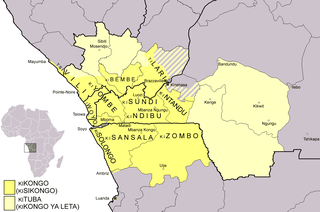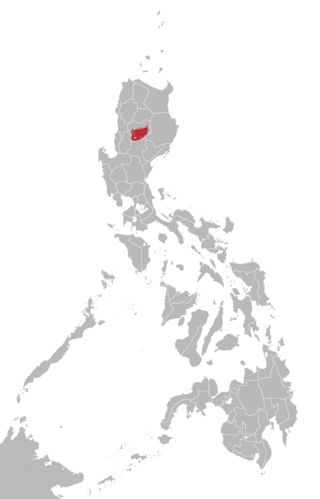Related Research Articles

The Corpus JurisCivilis is the modern name for a collection of fundamental works in jurisprudence, issued from 529 to 534 by order of Byzantine Emperor Justinian I. It is also sometimes referred to metonymically after one of its parts, the Code of Justinian.

Kongo or Kikongo is one of the Bantu languages spoken by the Kongo people living in the Democratic Republic of the Congo, the Republic of the Congo, Gabon and Angola. It is a tonal language. It was spoken by many of those who were taken from the region and sold as slaves in the Americas. For this reason, while Kongo still is spoken in the above-mentioned countries, creolized forms of the language are found in ritual speech of Afro-American religions, especially in Brazil, Cuba, Puerto Rico, the Dominican Republic, Haiti and Suriname. It is also one of the sources of the Gullah language and the Palenquero creole in Colombia. The vast majority of present-day speakers live in Africa. There are roughly seven million native speakers of Kongo, with perhaps two million more who use it as a second language.
Tokelauan is a Polynesian language spoken in Tokelau and historically by the small population of Swains Island in American Samoa. It is closely related to Tuvaluan and is related to Samoan and other Polynesian languages. Tokelauan has a co-official status with English in Tokelau. There are approximately 4,260 speakers of Tokelauan, of whom 2,100 live in New Zealand, 1,400 in Tokelau, and 17 in Swains Island. "Tokelau" means "north-northeast".
Mono, or Alu, is an Oceanic language of Solomon Islands reported in 1999 to be spoken by 660 people on Treasury Island, 2,270 on Shortland Island, and 14 on Fauro Island.

Ifugao or Batad is a Malayo-Polynesian language spoken in the northern valleys of Ifugao, Philippines. It is a member of the Northern Luzon subfamily and is closely related to the Bontoc and Kankanaey languages. It is a dialect continuum, and its four main varieties—such as Tuwali—are sometimes considered separate languages.

Preddvor is a town in Slovenia. It is the seat of the Municipality of Preddvor.
Kituba is a widely used lingua franca in Central Africa. It is a creole language based on Kikongo, a Bantu language. It is a national language in Republic of the Congo and Democratic Republic of the Congo.

In Norse mythology, Vili and Vé are the brothers of the god Odin, sons of Bestla, daughter of Bölþorn; and Borr, son of Búri.

Raka is a village in the Municipality of Krško in eastern Slovenia. The area is part of the traditional region of Lower Carniola. It is now included with the rest of the municipality in the Lower Sava Statistical Region. The village is known for a quality variety of onion.
Buol is an Austronesian language spoken in North-eastern Sulawesi, Indonesia.
Kaba proper is a Bongo–Bagirmi language of Chad and the Central African Republic. It is one of several local languages that go by the names Kaba and Sara. There are three ISO codes, which Ethnologue acknowledges may be the same thing.
Tombulu, also known as Minahasan language, is an Austronesian language of northern Sulawesi in Indonesia. It is a Minahasan language, a sub-group of the Philippine languages.
Bwaidoka is an Austronesian language spoken in Milne Bay Province of Papua New Guinea. It is a local lingua franca.
Mato is a minor Austronesian language of northern Papua New Guinea just inside Morobe Province. Mato is also referred to by the names Nenaya, Nengaya, and Nineia. Mato language has two minor variations, Tabares and Remuk, and the two variations are each spoken in three separate villages. While Mato is surrounded by several other languages, this has no effect on the grammar changes within Mato boundaries. The linguistic situation is very stable, due in part to the geographical isolation of the Mato people.
Bola, or Bakovi, is an Oceanic language of West New Britain in Papua New Guinea. The Harua (Xarua) dialect developed on a palm plantation.
Vili (Ibhili) is a minor Bantu language of Gabon.
Aoheng, or Penihing, is a Kayan language of East Kalimantan, Indonesia, one of several spoken by the Penan people.

Vili Resnik is a Slovenian rock singer and guitarist.

The Vili people are a Central African ethnic group, established in southwestern Gabon, the Republic of Congo, Angola and the Democratic Republic of Congo. It's a subgroup of Bantu and Kongo peoples.

Vili Beroš is a Croatian politician and neurosurgeon serving as Minister of Health since 2020.
References
- ↑ Civili is pronounced Tchivili and can also be pronounced Tshivili.
- ↑ Vili at Ethnologue (18th ed., 2015) (subscription required)
- ↑ Jouni Filip Maho, 2009. New Updated Guthrie List Online